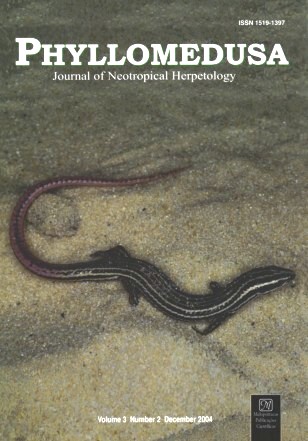Temporal and spatial changes in the diet of Hyla pulchella (Anura, Hylidae) in southern Uruguay
DOI:
https://doi.org/10.11606/issn.2316-9079.v3i2p101-103Keywords:
Anura, Hylidae, Hyla pulchella, diet, trophic ecologyAbstract
In this article we report the diet of a population of the hylid frog Hyla pulchella from southeastern Uruguay. We collected the specimens in ponds, where we identified microenvironments defined by the invertebrate assemblage, during one year divided into two seasons (warm and cold). We taxonomically determined 10365 invertebrates belonging to 21 categories in the digestive tracts of frogs. We estimated the diversity of the diet and alimentary preference according to microenvironments and seasons. We estimated the expected richness of both diet and prey availability using a null model based on the hypergeometric distribution. We performed Discriminant Analyses and Kruskal-Wallis tests to detect changes in prey availability among microenvironments and between seasons. The overall diet in terms of frequencies was composed primarily of arthropods (mainly Araneae, Diptera, Hymenoptera, and Coleoptera) and in terms of volume, by larvae. The most relevant items to study the microenvironmental and seasonal variation in the available preys were Araneae, Collembola, Homoptera, Hymenoptera, Diptera, Dictioptera, Lepidoptera, Coleoptera, and larvae. Based on the null model curves and preference indexes we inferred positive selection by larvae, Isopoda, Dictioptera, Lepidoptera, and Diptera, and negative selection by Collembola and Hymenoptera. The diversity of diet and the null model curves indicated that the diet changes among microenvironments and seasons. This frog may be considered as a middle generalist predator, with some selective behavior and a combined search strategy (active and sit-and-wait). We conclude that the knowledge about the availability of preys is a relevant tool for trophic studies.Downloads
Download data is not yet available.
Downloads
Published
2004-12-01
Issue
Section
Articles
License
All material originally published in Phyllomedusa belongs to Escola Superior de Agricultura Luiz de Queiroz - Universidade de São Paulo. All contents are under a license of Creative Commons BY-NC-ND.How to Cite
Maneyro, R., & Rosa, I. da. (2004). Temporal and spatial changes in the diet of Hyla pulchella (Anura, Hylidae) in southern Uruguay. Phyllomedusa: Journal of Herpetology, 3(2), 101-103. https://doi.org/10.11606/issn.2316-9079.v3i2p101-103



 Impact Factor (JCR): 0.400
Impact Factor (JCR): 0.400 CiteScore: 1.0
CiteScore: 1.0